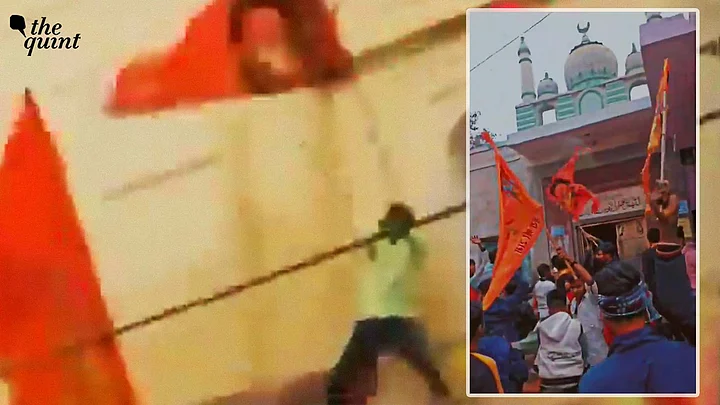A mob attempted to hoist saffron flags on the centuries’ old Diwanji Begum mosque in Uttar Pradesh’s Agra on 22 January, in celebration of the Ram Temple consecration. In videos of the incident that went viral, the mob can be seen dancing and holding saffron flags as they climb on top of the mosque, attempting to hoist them.
The mosque, in Agra’s Tajganj area, was built in A.D. 1677 and was commissioned by Diwanji Begum, mother of Mumtaz Mahal. The Mughal era mosque comes under the Agra circle of the Archaeological Survey of India.
The caretaker of the mosque, Zahir Uddin, filed a complaint in the Tajganj police after the incident, where he claimed that “1000-1500 people” were present at the gate of the mosque, trying to hoist the flags. The complainant also claimed that several slogans were being raised,” and the “anti-social elements” had “desecrated the mosque”. 12 people have been arrested for the act, so far.
12 Arrested, All Locals: Police
The Tajganj police have registered an FIR against the 1000-1500 unknown individuals, and have identified and arrested 12 so far.
“Everyday we are identifying more and more people from the videos and making arrests. So far, we have arrested 12 individuals,” Station House Officer Tajganj Jasveer Singh told The Quint. The SHO said that the arrested are all locals from Agra. “The complainant has said 1000-1500 people, but as per videos it seems like roughly 100 people were part of the mob,” the SHO said.
The FIR has been registered under IPC Sections 147 (rioting), 148 (armed with a deadly weapon), 452 (trespassing with preparation to hurt or assault) and 505 (2) (statements to create public mischief between groups).
However, the SHO said that the IPC Section 452 will now be dropped. "That was added as per initial probe. Now, with ongoing investigation, it doesn't seem like the section applies," the SHO said. He added that these were men participating in "celebrations" over the Ram Temple inauguration in Ayodhya.
The mosque is located in Billochpur locality of Tajganj, Agra and is recognised as a monument under the Archaeological Survey of India. As per the ASI’s Agra Circle website, “the mosque stands on a highly elevated podium. Rectangular in plan, it is built of red sandstone. Arches are thrown across the sanctuary. The mosque is crowned by three domes, the middle one being larger. The mosque represents Shah Jahani style of architecture. The date of its construction is recorded in a Persian inscription as A.H. 1088 (A.D. 1677).”
Several incidents have come to light in the last week, since the Ram Mandir consecration ceremony in Ayodhya on 22 January, of violence, skirmishes and vandalism. At least 6 states have witnessed some violent incident, including Maharashtra where violence occurred at Mira Road, after which the authorities demolished many houses and shops.
(At The Quint, we question everything. Play an active role in shaping our journalism by becoming a member today.)
